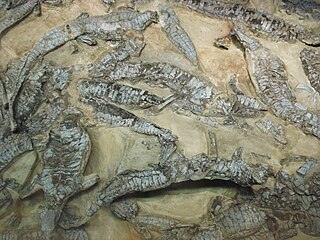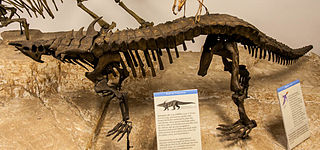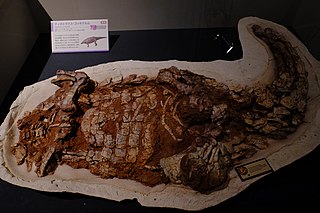
Aetosaurs were heavily armored reptiles belonging to the extinct order Aetosauria. They were medium- to large-sized omnivorous or herbivorous pseudosuchians, part of the branch of archosaurs more closely related to crocodilians than to birds. All known aetosaurs are restricted to the Late Triassic, and in some strata from this time they are among the most abundant fossil vertebrates. They have small heads, upturned snouts, erect limbs, and a body ornamented with four rows of plate-like osteoderms. Aetosaur fossil remains are known from Europe, North and South America, parts of Africa and India. Since their armoured plates are often preserved and are abundant in certain localities, aetosaurs serve as important Late Triassic tetrapod index fossils. Many aetosaurs had wide geographic ranges, but their stratigraphic ranges were relatively short. Therefore, the presence of particular aetosaurs can accurately date a site that they are found in.

Stegosauridae is a clade of thyreophoran dinosaurs within the suborder Stegosauria. The clade is defined as all species of dinosaurs more closely related to Stegosaurus than Huayangosaurus. The name ‘Stegosauridae’ is thus a stem-based name taken from the well-represented genus – Stegosaurus. Fossil evidence of stegosaurids, dating from the Middle Jurassic through the Early Cretaceous, have been recovered from North America, Eurasia and Africa.

Aetosaurus is an extinct genus of pseudosuchian reptile belonging to the order Aetosauria. It is generally considered to be the most primitive aetosaur. Three species are currently recognized: A. ferratus, the type species from Germany and Italy; A. crassicauda from Germany; and A. arcuatus from eastern North America. Additional specimens referred to Aetosaurus have been found in the Chinle Group of the southwestern United States, and the Fleming Fjord Formation of Greenland. Specimens of Aetosaurus occur in Norian-age strata.

Desmatosuchus is an extinct genus of archosaur belonging to the Order Aetosauria. It lived during the Late Triassic.
Calyptosuchus is an extinct genus of aetosaur from the Late Triassic of North America. Like other aetosaurs, it was heavily armored and had a pig-like snout used to uproot plants.

Typothorax is an extinct genus of typothoracisine aetosaur that lived in the Late Triassic. Its remains have been found in North America. Two species are known: T. coccinarum, the type species, and T. antiquum.
Chilenosuchus is an extinct genus of aetosaur. Fossils have been found in the El Bordo Formation, in the Antofagasta Region in northern Chile.
Coahomasuchus is an extinct genus of aetosaurine aetosaur. Remains of the genus have been found from deposits in Texas and North Carolina that date to the Otischalkian faunachron of the Late Triassic. It was small for an aetosaur, being less than 1.5 metres long. The dorsal plates are distinctively flat and unflexed, and have a faint sub-parallel to radial ornamentation. The genus lacked spines or keels on these plates, features seen in many other aetosaurs. Coahomasuchus was very similar in appearance to the closely related Aetosaurus.
Rioarribasuchus is a genus of aetosaur. Fossils have been found from the Chinle Formation in Arizona and New Mexico that date back to the upper Late Carnian stage of the Late Triassic.
Lucasuchus is an extinct genus of aetosaur. Fossils have been found from the Bull Canyon Formation of the Dockum Group outcropping in the Revuelto Creek locality in Quay County, New Mexico. All specimens date back to the Norian stage of the Late Triassic. The genus was named in 1995 after the American paleontologist Spencer G. Lucas.
Tecovasuchus is an extinct genus of aetosaur. It is known primarily from osteoderms found from the Tecovas Formation in Texas, which is Late Triassic in age, dating back to the lower Norian. Material is also known from several other localities of the Chinle Group in New Mexico and Arizona, such as older Carnian outcrops and younger Rhaetian outcrops. Specimens of Tecovasuchus have been collected from the Tecovas Formation, the Bluewater Creek Formation, and the Los Esteros Member of the Santa Rosa Formation.

Aetosaurinae is one of the two main clades of aetosaurs, the other being Desmatosuchia. It is a stem-based taxon defined as all aetosaurs more closely related to Aetosaurus than to the last common ancestor of Desmatosuchus. The only synapomorphy that diagnoses the clade Aetosaurinae is the medial offset of the dorsal eminences of the paramedian osteoderms. A phylogenetic study in 2012 found Aetosaurinae to be paraphyletic, with Aetosaurus being the basal-most stagonolepidid and aetosaurines like Calyptosuchus, Neoaetosauroides, and the newly described Aetobarbakinoides being successively more derived taxa leading up to a clade containing Desmatosuchinae and Typothoracisinae. Under this phylogeny, most traditional aetosaurines are more closely related to Desmatosuchus than they are to Aetosaurus, and the clade Aetosaurinae can only include Aetosaurus. However, new phylogenies have recovered Typothoracisinae within Aetosaurinae, making Aetosaurinae a valid clade once more.
Paratypothoracisini is a clade of aetosaurs within the subfamily Aetosaurinae. It is a node-based taxon that includes Heliocanthus, Paratypothorax, Tecovasuchus, and all descendants of their most recent common ancestor. All synapomorphies that diagnose the clade can be found in the osteoderms. These include dorsal eminences of the paramedian plates that never or almost never contact the posterior margins of the plates and dorsoventrally flattened "horns" formed from the lateral spikes of the cervical and anterior dorsal regions.

Desmatosuchinae is one of the two subfamilies of aetosaurs, the other being Aetosaurinae. It is a stem-based taxon defined as all aetosaurs more closely related to Desmatosuchus than the last common ancestor of Desmatosuchus and Stagonolepis. All synapomorphies that diagnose the clade can be found in the osteoderms. These include tongue-and-groove articulations for lateral plates present in dorsal presacral paramedian plates and large spikes on the lateral cervical, dorsal, and caudal plates.
Redondasuchus is an extinct genus of aetosaur. It may a junior synonym of Typothorax coccinarum, another aetosaur. Redondasuchus is a member of the clade Typothoracisinae within the subfamily Aetosaurinae, and lived during the middle Norian stage of the Late Triassic. Material belonging to the genus has been found from the Redonda Formation in east-central New Mexico. The type species, R. reseri, was named in 1991 after having been referred to as a species of Typothorax since 1985. A second species, R. rineharti, was described in 2006.
Sierritasuchus is an extinct genus of aetosaur in the subfamily Desmatosuchinae. It is known from a small holotype skeleton from the Late Triassic Tecovas Formation of Texas. This skeleton was discovered in 1939 and was originally assigned to the genus Desmatosuchus. It was placed in its own genus in 2008 after having been in the collections of the University of Michigan Museum of Paleontology, with the type species being S. macalpini. The generic name refers to Sierrita de la Cruz Creek where the holotype was found, and the specific name refers to Archie MacAlpin, who discovered the skeleton. Based on the histology of the scutes of the holotype, the individual was a subadult that was not fully grown.
Aetobarbakinoides is an extinct genus of stagonolepidid aetosaur known from the Late Triassic of Rio Grande do Sul state, southern Brazil. Fossils have been found from the Santa Maria Supersequence of the late Carnian and early Norian stages, making Aetobarbakinoides one of the oldest aetosaurs. The type species, A. brasiliensis, was named in 2012, and is notable for being described primarily by features of the vertebrae; most other aetosaurs are diagnosed by features in bony plates called osteoderms, which are by far the most common material. Although placed in a basal phylogenetic position among aetosaurs, Aetobarbakinoides is closely related to both desmatosuchines and typothoracisines, two derived clades of aetosaurs.
Polesinesuchus is an extinct genus of stagonolepidid aetosaur known from the Late Triassic of southern Brazil. Fossils have been found from the Santa Maria Supersequence of the late Carnian and early Norian stages, making Polesinesuchus one of the oldest aetosaurs. It contains a single species, Polesinesuchus aurelioi, the fifth aetosaur species known from South America to date. Anatomical evidence suggests that Polesinesuchus likely represents a juvenile individual of the contemporary Aetosauroides.
Nundasuchus is an extinct genus of crurotarsan, possibly a suchian archosaur related to Paracrocodylomorpha. Remains of this genus are known from the Middle Triassic Manda beds of southwestern Tanzania. It contains a single species, Nundasuchus songeaensis, known from a single partially complete skeleton, including vertebrae, limb elements, osteoderms, and skull fragments.
Gorgetosuchus is an extinct genus of aetosaur from the Late Triassic of the eastern United States, represented by the type species Gorgetosuchus pekinensis. G. pekinensis was named and described by Heckert et al. (2015) on the basis of ten rows of bony plates called osteoderms, representing the front part of an armored carapace that would have covered the back of the animal. These plates were found embedded in sandstone and conglomerate boulders near a brick quarry in Chatham County, North Carolina, which likely originated from the Late Triassic Pekin Formation.. Gorgetosuchus was part of a diverse faunal community in a continental rift valley system during the Late Triassic, which also included traversodontids, phytosaurs, dicynodonts, and temnospondyls. Gorgetosuchus coexisted with two other aetosaurs, Lucasuchus and Coahomasuchus.






